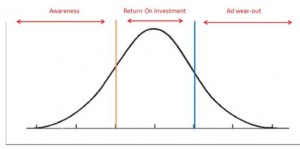You just saw a commercial for the nth time and you think to yourself, “doesn’t this company know that they are wasting their advertising money.” This is a stage where your audience is still receiving Impressions, but their propensity to Convert has diminished. There is a name for this phenomenon, and it is called Ad Ware-Out. With digital media, we are very lucky, because we can track when this phenomenon happens and I will tell you how to do so.
 First, lets look at how this happens in the digital media return on investment bell curve below. First stage in the curve is Awareness, every campaign has a stage where the customer is becoming aware of your offering. Awareness, slowly ramps up into a stage that is between the orange and blue bar called Return On Investment. This middle stage, is where most of your revenue is gained as users are aware of your product and are purchasing.
First, lets look at how this happens in the digital media return on investment bell curve below. First stage in the curve is Awareness, every campaign has a stage where the customer is becoming aware of your offering. Awareness, slowly ramps up into a stage that is between the orange and blue bar called Return On Investment. This middle stage, is where most of your revenue is gained as users are aware of your product and are purchasing.
After the Return on Investment stage, the blue bar indicates a shift in the cure towards the ad wear-out. This stage is critical to detect as your margins diminish considerably after this stage. The ad ware-out stage will be different for various digital publishers due to different audience sizes. The ad wear-out point is also different for various verticals. Thus, it is important to set up triggers to detect when the blue line hits, and ads start to wear out your audience.
Ad wear-out Trigger: Engagement
In most campaigns, engagement has a very high correlation with conversion. When your engagement starts to diminish, more than likely so will your conversion. Setting up ways to detect engagement decline will trigger that your campaign may be getting close to the blue line, and ad wear-out.
Ad wear-out Trigger: Average Frequency
When you find how many unique individuals users saw a campaign from a particular advertising publisher, this is your Reach number. The Frequency number is how many times each individual saw your advertisement. If you take the total impressions for a specific publisher, and divide that by uniques, you will get the average frequency. Formula below:
Impressions / Uniques = Average Frequency
When you find the average frequency, you will see how often each individual sees your ad. This is very important to correlate to your ROI. In most cases, too large of a frequency means you are wasting your money. Running a campaign without an average frequency cap is a huge waste of money and basically removes the blue line in the bell curve above.
Conclusion
When running campaigns, you want to find the triggers for ad wear-out and consult your media partners to optimize your campaign. This comes down to knowing your campaign KPIs and a strong tagging strategy as well as knowing your digital media ad serving platform. It can also be as simple as knowing the publisher audience universe and planning accordingly. If you are using a publisher that has 1K unique visitors per month, creating an advertising campaign with 100K impressions per month for that publisher will be wasteful and you will spam the users.
Related Posts:
Using custom floodlight tags in digital media campaigns
3 things to avoid in digital media tagging strategy